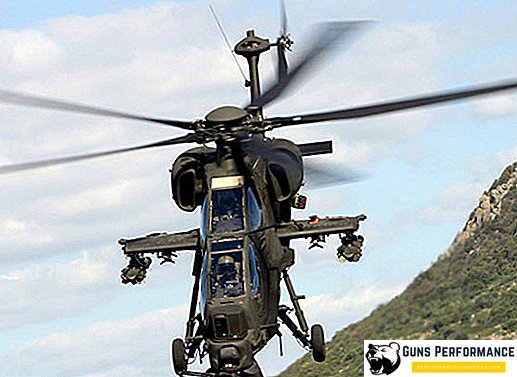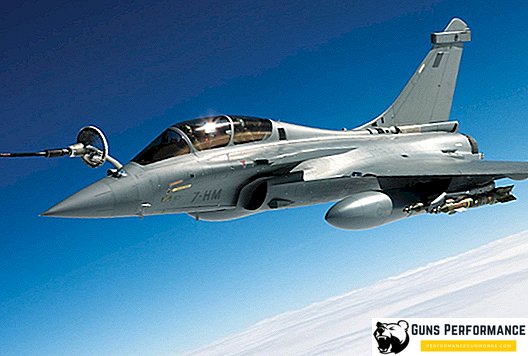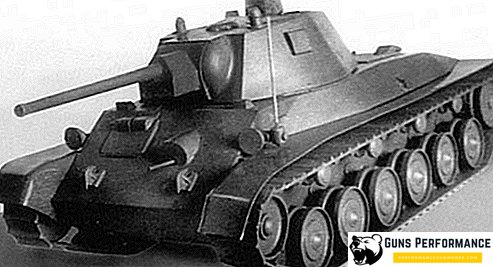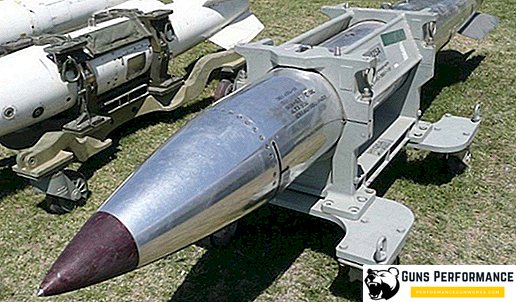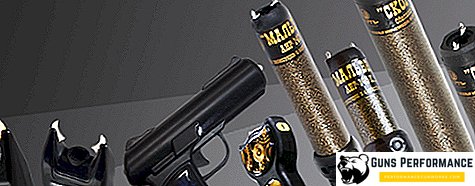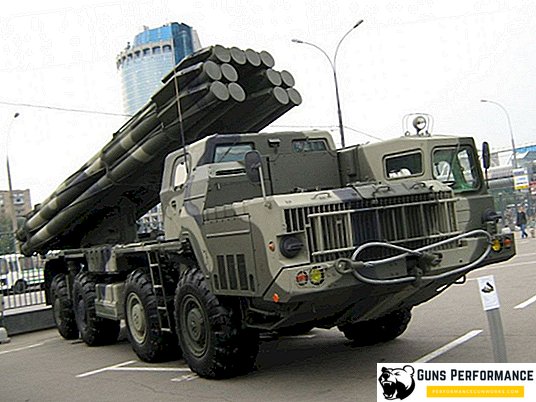
The LNG-9 Spear (in the Sapog military jargon) is a Soviet heavy-duty grenade launcher designed primarily to destroy enemy armored vehicles. Later, a fragmentation grenade was developed for this weapon, which could be used to defeat the enemy's manpower. The caliber "Spear" is 73 mm.
The LNG-9 grenade launcher is a powerful fire-fighting device for motorized rifle units and parachute units. The grenade launcher was developed by a group of designers GKSB-47 (today it is NPO Bazalt).

The armament LNG-9 grenade launcher was adopted in 1963, and it is still in service with the Russian army. This weapon was used in a variety of military conflicts of the second half of the last century, it was successfully used by both regular troops and various partisan units. LNG-9 production was launched in China, Egypt, Bulgaria and Pakistan.
The SPG-9 anti-tank grenade launcher is a simple and reliable weapon, the effectiveness of which has been repeatedly confirmed by practice. LNG-9 belongs to the second generation of domestic anti-tank weapons. During the period of mass production, several modifications of the grenade launcher were developed. On the basis of one of them, the LNG-9M was later created a 73-mm gun for the BMP-1 and BMD-1 combat vehicles.
The main drawback of the LNG-9 can be called its very "solid" weight, which significantly reduces the mobility of these weapons. However, despite this, as well as the presence of a large number of more modern grenade launchers, the "Boot" constantly flashes in reports shot in local conflicts.

History of creation
The first grenade launchers began mass production during the Second World War. "Faustprony" and "bazookas" perfectly showed themselves on the battlefield and gave the infantry an excellent tool for dealing with enemy armored vehicles - easy, simple and very effective. The Soviet fighters enjoyed using captured Faustpatrons and Panzershrekami, they were especially murderous for enemy armored vehicles in urban combat conditions.
Already during the war, work began on the creation of the first Soviet RPG-1 hand-held grenade launcher, but it was never accepted for service. But in 1949 a more successful RPG-2, which had been in service for several decades, began to arrive in the army.
In the 1950s, the Soviet military somewhat cooled to hand-held anti-tank weapons. It was believed that the following conflicts would have a global dimension, and aviation, missiles and thermonuclear weapons would play the main role in them. However, along with this, local wars were constantly arising, in which it was necessary to fight the enemy’s armored vehicles, and it was the grenade launchers that best suited for this. In addition, in the Soviet Union much attention was paid to the airborne troops, and for their armament anti-tank guns were too heavy.

Already in the late 50s, the USSR began developing two grenade launchers at once, which in the future became one of the most famous models of this weapon - the RPG-7 and the SPG-9. The creators of the SPG-9 were initially tasked with creating a simple and unpretentious grenade launcher weighing no more than 30 kilograms that could pierce up to 300 mm of armor.
The development of a grenade launcher ended in 1962, then tests followed, and a year later the LNG-9 was put into service. There are still a lot of questions about the strange caliber of the weapon - 73 mm. There was a legend that this size is related to the diameter of a bottle of vodka, which was most popular in the USSR at that time. But this, of course, is fiction. Initially, the LNG-9 caliber was 70 mm, but the gunsmiths had to add a thin lead belt to the grenade design, which not only fixed it, but also cleaned off the powder carbon in the gun barrel. It was he who added the "non-standard" three millimeters.

Immediately after the introduction of the SPG-9 grenade launcher, it had only one type of ammunition - the PG-9V shot, later the list of grenades was significantly expanded:
- PG-9V. Shot with anti-tank cumulative PG-9 grenade, its mass is 4.4 kg, the weight of the grenade itself is 1.3 kg. It is equipped with a piezoelectric fuse and can penetrate 300 mm of armor.
- PG-9VS. This is a modification of the basic ammunition PG-9V. The grenade has the best armor penetration (400 mm), but the range and the initial speed of the grenade at PG-9V and PG-9VS are the same.
- OG-9B. Shot with an OG-9 high-explosive fragmentation grenade designed to destroy enemy infantry. It has a greater weight (5.35 kg) compared with cumulative ammunition. OG-9B was created much later than anti-tank shots. The initial speed of a grenade is less (315 m / s), but it flies farther - 910 m.
- OG-9VM. An improved high-explosive fragmentation shot with an OG-9M grenade.
Later, on the basis of the base model of the grenade launcher, an amphibious modification of the SPG-9D was created on a wheel track.
Description of construction
The LNG-9 is a smooth-bore, recoilless, gas-dynamic weapon. After the shot, part of the powder gases is ejected through a nozzle located in the breech of the grenade launcher, which significantly reduces recoil.
The grenade launcher includes a grenade (cumulative or high-explosive fragmentation) and a small starting powder charge, with which it leaves the bore and receives initial acceleration. After a few tens of meters of flight, the own grenade engine starts to work, which accelerates it to the optimum speed. The grenade has a caliber warhead and a six-blade stabilizer, as well as two tracer.

The starting charge of the shot is a metal charger (in the form of a perforated tube), a charge of nitroglycerin powder, an igniter charge with an electric igniter and a boosting unit. The charge is easily and quickly attached to the grenade.

The LNG-9 consists of a barrel with a slide, a tripod (in the landing version it has a wheel travel), sighting devices and a mechanism for producing a shot.
The barrel of the weapon is a 73 mm smooth-bore pipe with an expansion chamber and a breech. On the trunk is a bolt with the mechanism of unlocking and locking. In addition, the SPG-9 barrel houses a handle for carrying a grenade launcher, a front sight with a base, a bracket for attaching sights, a strap with a mechanical sight, a special shield that protects the gunner’s operator from burns, a throwing mechanism, an electrostreating mechanism and a conducting wire. The shutter with nozzle is opened by turning to the left.
With the help of two trunnions (front and rear) the barrel is mounted on a tripod machine. The SPG-9 machine has horizontal and vertical guidance mechanisms; thanks to the leg position adjustment, the height of the line of fire varies from 390 to 700 mm.
When firing direct fire, a PGO-9 optical sight is used, its multiplicity is 4.2.
LNG-9 is designed to destroy enemy tanks, its self-propelled artillery, other armored vehicles, as well as manpower, which is open or in shelters. The calculation of the grenade launcher includes four people: a podnoschik, loader, gunner and the commander of the gun.

In the stowed position, the SPG-9 is dismantled on the machine, barrel and sights. The weight of the grenade launcher is almost 50 kg (49.5), therefore, in the assembled state, it can be moved only at short distances by all the crew members.
The shot is as follows: using the handle, the shutter opens and a grenade with a powder starting charge is sent to the breech of the weapon. Closing the gate closes the start-up circuit, and the gunner cocks the trigger using a special handle. This design eliminates the possibility of launching a grenade with the shutter not fully closed.
After pressing the trigger, an electrical impulse through the igniter ignites the starting charge, which ejects the grenade from the barrel and gives the initial velocity. In this case, the tail of the shot is separated from the grenade and remains in the breech.
The grenade, due to the forcing of powder gases through inclined holes, acquires a rotational motion that stabilizes its flight, and after a few meters after its departure from the trunk, its stabilizers are revealed. At a distance of 15-20 meters from the edge of the barrel, the main engine of the ammunition is activated, and its speed rises to its maximum.

To make a re-shot, you just need to open the bolt and send a new ammunition. Elements of the previous shot are extracted from the breech of the grenade launcher automatically. The LNG-9 has a significant rate of fire, it reaches six rounds per minute and significantly exceeds the first and second generation anti-tank missile systems. The fact is that the gunner does not need to direct a grenade and wait until it hits its target. It should be added that the shooting of the LNG-9 is not too difficult and does not require long preparation.

The high speed of a grenade allows you to make minimal corrections when shooting, and even without them.
Modifications
During serial production, several modifications of the LNG-9 grenade launcher were developed:
- LNG-9D. An airborne modification of a grenade launcher, it is equipped with a wheel drive machine;
- LNG-9M. An upgraded version of the base modification with the new PGOK-9 sight. It allows firing and standard cumulative ammunition and high-explosive fragmentation.
- LNG-9DM. An upgraded version of the landing version of the grenade launcher. Differs sight PGOK-9.
- PGN-9. Modification with night sight.

Specifications
| Caliber, mm | 73 |
| Total weight kg | 49,5 |
| Sizes, mm: | |
| length | 2110 |
| width | 1055 |
| height | 820 |
| The height of the line of fire, mm | 390-700 |
| Sighting range, m | 1300 |
| Firing range, m | 800 |


